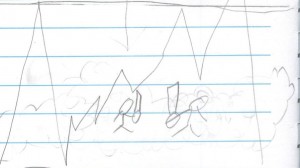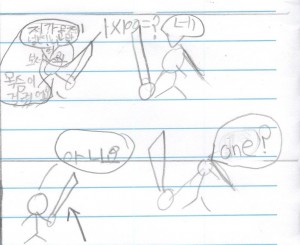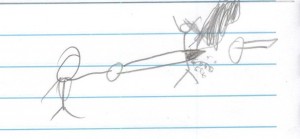As an EAL teacher, I spend a lot of time in the elementary classrooms helping kids who speak English as an Additional Language. Recently, I visited third grade, where students were writing narratives. The teacher had provided a framework, which students copied into their writing books: introduction, beginning event, resolution, conclusion. Next, children sketched an illustration next to each step in their stories in preparation for writing.
I sat down with a Korean boy (I’ll call him Ji-Hun here), who started at our school mid-year with no English. He had scribbled a bunch of Korean notes, which of course I couldn’t check, to clarify what each section of his story should include. My usual M.O. is to have the kid describe the pictures to me, and I dictate the story back to him in accurate English. Then he tries to recreate the story in his own words with some help from me, first verbally and then in writing.
Ji-Hun had drawn this picture first. After a lot of gestures and random nouns, I realized it was a Korean mountain range, and those two guys were having a sword fight. We spent a lot of time trying to figure out “mountain” because he kept insisting “berry cold, berry cold,” which made me think he was describing a glacier or Antarctica or something. So, OK, we had a setting.

His next drawings show the fight sequence. The first warrior asks, “What is 1 X 100?” The other clearly less intelligent warrior answers, “One?”

Hmmm… well. Not sure what to make of that.
The smart warrior simply wasn’t going to tolerate such poor math skills, so he plunges his sword into the dumb warrior’s belly.

Ji-Hun described it to me basically just as I have written it. Was the second fighter trying to solve a riddle to cross the mountain pass? I acted this out, but he denied that was the purpose of the math battle. I couldn’t think of any other reason for a sword fight to ensue over multiplication. He tried to explain in Korean, while tugging on his hair with exasperation.
I just couldn’t let it go. Finally, we went next door to a different third grade class, where I asked another Korean student (with stronger English skills) to discuss the story with Ji-Hun. After a couple minutes of chatting, the student erupted in laughter. “He understands that every narrative has to have a problem and a resolution,” he said. “But he thinks the ‘problem’ has to be a MATH problem.”
Mystery solved! We all had a good chuckle.
Then I sat down with Ji-Hun and made up short stories off the top of my head for him to identify the problem. “The little cat is so hungry. She looks everywhere for food, but she can’t find any. Then Miss Sharon gives it some milk. The end.” What’s the problem? Yes, the cat is hungry. What’s the resolution? Yes, Miss Sharon gives it some milk. And so on.
Eventually, the light bulb went off and Ji-Hun revamped his story. In the new version, he and his family are hiking in the aforementioned mountains. He gets distracted and falls behind. Soon he loses them completely and can’t find his way home. He walks and walks, crying out for help. Finally, a friend finds him and points out that his house is only a few meters away. It won’t win any prizes, but at least he gets the idea.
Today’s English lesson: When you write a narrative, math is optional.
